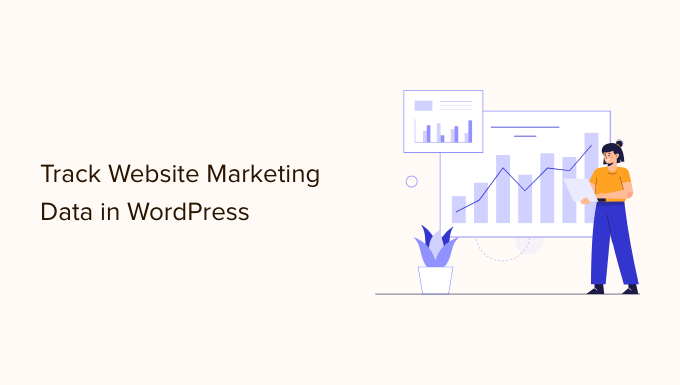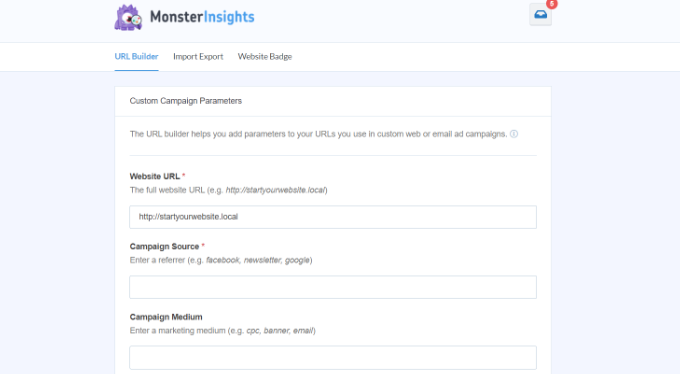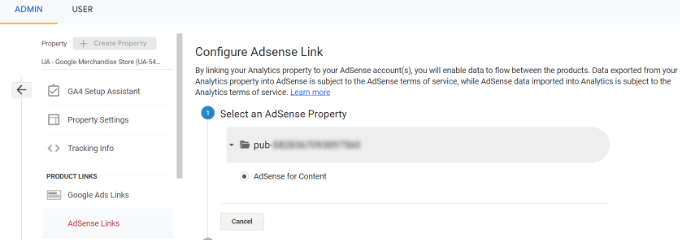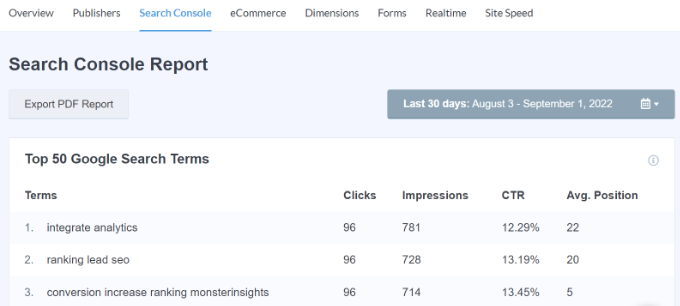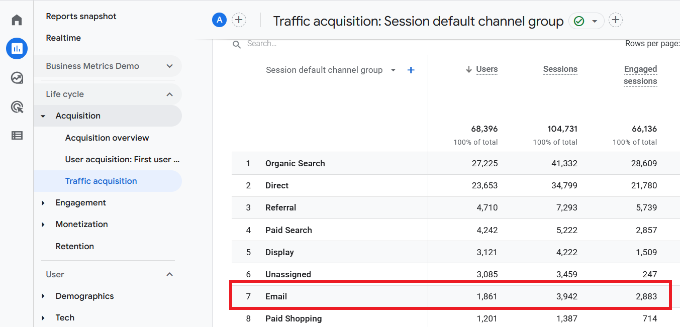Do you want to track key metrics like email signups or sales for your site?
If you want your site to be successful, then you need detailed metrics like which pages are getting you the most signups, which traffic source is producing the best results, and more.
In this article, we’ll show you how to set up Google Analytics goals for your WordPress site.

What Are Goals in Google Analytics?
Goals are user interactions that you can track using Google Analytics.
You can set up goals to measure conversions, track sales, email sign-up forms, and more.
All this can help you make more money online and increase your website conversions.
Note: Google Analytics 4 (GA4) replaces Goals with Events, and on July 1, 2023, GA4 will replace the current Universal Analytics. In this post, we will show you how to set up tracking for both Events and Goals simultaneously using the MonsterInsights Dual Tracking feature, as well as how to use Events in GA4 itself.
Why You Need to Create Good Goals in Google Analytics
With goals, you can find out all sorts of details about your site. For instance:
- If you sell digital products, you could use goals to find out which sources are driving the most sales.
- If you run an eCommerce store, you could use goals to see where customers will most likely abandon the checkout process.
- If you’re a personal trainer with a fitness blog, you could use goals to see which posts encourage prospects to fill out your contact form.
Creating the right goals for your site is important. If you have an online store, there’s not much point in setting a goal to track how many people visit your About page. Instead, your goal should be how many customers buy from you.
Let’s look at how to set up goals in Google Analytics. Here’s what we’re going to cover. Use the quick links to jump straight to that part of the tutorial:
Setting Up Google Analytics in WordPress with MonsterInsights
The best way to set up Google Analytics is using MonsterInsights. It is the best analytics plugin for WordPress and automatically sets up tracking for you, and saves a lot of work.
First, you’ll need to install and activate the MonsterInsights plugin. For more details, please check out our guide on how to install a WordPress plugin.
Note: You’ll need the Pro version of the plugin or higher to unlock advanced tracking features and reports like the eCommerce report and the form conversions report. There is also a MonsterInsights Lite version you can use for free to get started.
After activating MonsterInsights, you’ll see the welcome screen in your WordPress dashboard. Simply click the ‘Launch the Wizard’ button and follow the onscreen instructions.

For more help, check out our instructions on how to install Google Analytics on your site using MonsterInsights.
You can also use the Dual Tracking feature to set up Google Analytics 4 (GA4) tracking in WordPress. GA4 is the latest version of Analytics, and it will replace Universal Analytics on July 1, 2023.
After the sunset date, you won’t be able to track data in Universal Analytics and will have to start from scratch. That’s why we recommend swapping to GA4 sooner rather than later. For more details, please see our guide on switching to Google Analytics 4 in WordPress.
Automatically Track Goals by Using MonsterInsights
Now that you’ve connected Google Analytics with your WordPress site, you can use MonsterInsights to set up goals automatically.
This method is recommended for beginners because you don’t have to manually create goals, edit code, and worry about your tracking working properly.
MonsterInsights helps you track conversions like eCommerce sales, form submissions, file downloads, link clicks, video plays, and more.
Let’s take a closer look at each of these in detail.
Tracking eCommerce Conversion in WordPress
Do you want to find out how many visitors are converting into paying customers?
In Google Analytics, you’d have to set up goals to track specific actions customers perform. This can be tricky for beginners, and it might require editing the tracking code.
However, the MonsterInsights eCommerce addon lets you easily track data from a WooCommerce store. You can also use it with MemberPress, LifterLMS, Easy Digital Downloads, and other eCommerce plugins.
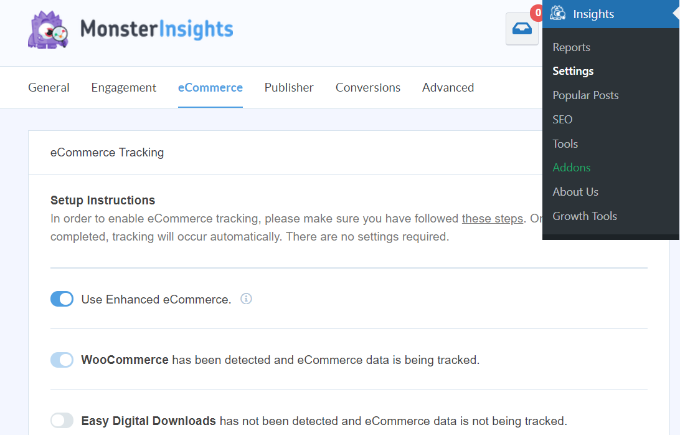
For more details, please see our step-by-step guide on how to set up eCommerce tracking in WordPress.
The best part is that you don’t have to modify the tracking code. MonsterInsights handles everything else for you.
After setting up tracking, you can head to Insights » Reports and click on the ‘eCommerce’ tab to view your report. Once you’ve had some sales, it’ll look something like this:
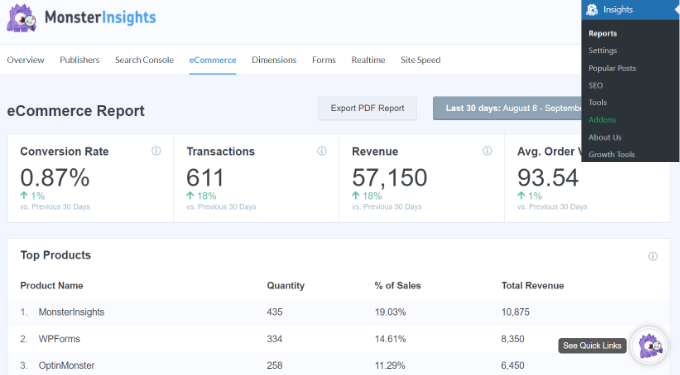
You won’t have to manually set up goals or events to track eCommerce conversions. The plugin will let you see all sorts of other insights, like your top conversion sources, the total of products added to carts, and the total removed from carts.
You can even see how many days it typically takes people to make a purchase, and how often people visit before making a purchase.
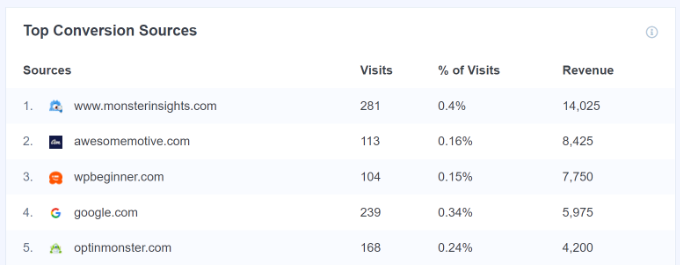
MonsterInsights also shows the percentage of new customers that bought a product for the first time from your store. It even shows a percentage of abandoned checkouts. You can use this data to reduce cart abandonment and convert users into paying customers.
Tracking Form Submissions in Google Analytics
Another great way to use Google Analytics and MonsterInsights is to track form conversions.
You can do this for any type of form. Here are just a few examples:
- Non-fiction author: A form where people sign up for your email newsletter to hear about your upcoming books.
- Realtor: A contact form where prospective clients fill in their details so you can call them back and arrange viewings.
- Personal trainer: A booking form that customers use to book and pay for their personal training session.
- Restaurant: A form that customers use for ordering food delivery.
MonsterInsights works with all WordPress contact form plugins and helps you track form submissions.
To start tracking form conversions in MonsterInsights, go to Insights » Addons and find the Forms addon. Simply click the Install button beneath it to install and activate it.
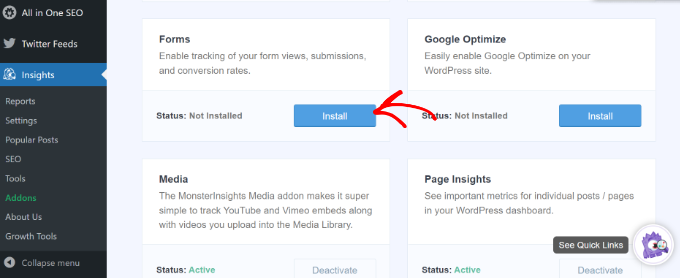
This addon lets you track form submissions as ‘Events’ in Google Analytics 4. You don’t have to set up anything extra.
Once you’ve installed and activated the addon, you’re done! Just go to Insights » Reports and click on the ‘Forms’ tab to see your report.
After you’ve had some form submissions, it’ll look something like this:
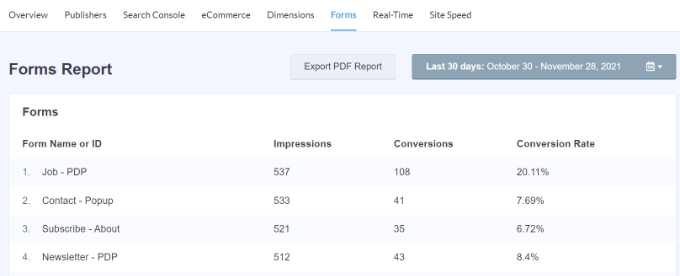
Tracking Link Clicks and File Downloads in Google Analytics
MonsterInsights automatically adds tracking for link and button clicks on your WordPress site. It works out of the box, and you don’t have manually set up goals for tracking different user actions on your site.
You can view the report inside your WordPress dashboard. Simply go to Insights » Reports and click the ‘Publishers’ tab.
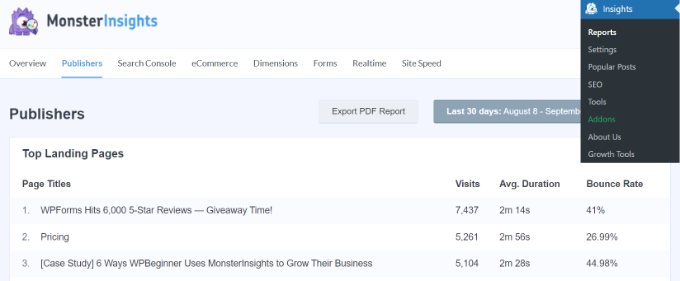
For instance, you can see which outbound links users click the most on your website.
Using this information, you can sign up for affiliate programs, get backlinks, submit guest posts, and uncover partnership opportunities.

If you have affiliate links on your site, then MonsterInsights also tracks them in Google Analytics. You can see your top-performing affiliates and promote them throughout your site to get more conversions.
MonsterInsights also automatically tracks file downloads on your site. If you offer downloadable content like ebooks, software, plugins, PDFs, and spreadsheets, then the analytics plugin tracks them in Google Analytics.
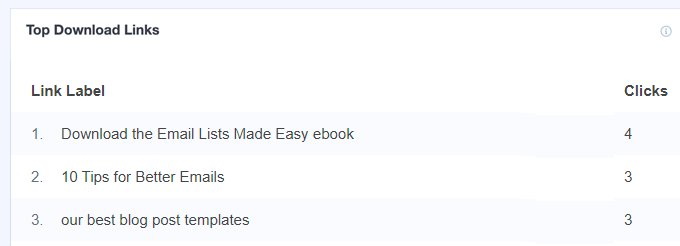
Tracking Video Plays in Google Analytics
If you have video content embedded on your site, then MonsterInsights can track them in Google Analytics and show which media content performs the best. It automatically tracks YouTube and Vimeo embeds along with other videos uploaded to your Media Library.
All you need to do is install the MonsterInsights Media addon by going to Insights » Addons from your WordPress dashboard.
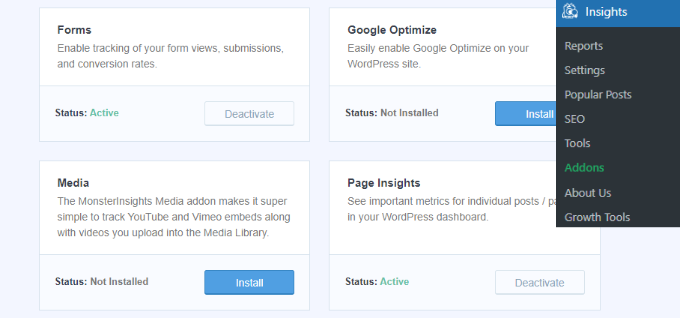
Once the addon is active, you can view reports in your WordPress dashboard.
Simply head to Insights » Reports and click the ‘Media’ tab.
Here, you’ll see a graph of how many people played videos on your site in the past 30 days.
If you scroll down, then you can view more details about individual videos. For instance, the report will show video plays, average watch time, average percentage watched, and completion rate for each piece of media content.
For more details, please see our guide on how to track video analytics in WordPress.
Setting Up Goals Manually in Google Analytics
If you don’t want to use MonsterInsights, or if you want to track a different type of goal, then you can do this manually in Google Analytics.
Do note that the latest version of Analytics (GA4) doesn’t have goals. You can only set up goals manually in Universal Analytics.
First, log in to your Universal Analytics account and click the ‘Admin’ tab on the bottom left.
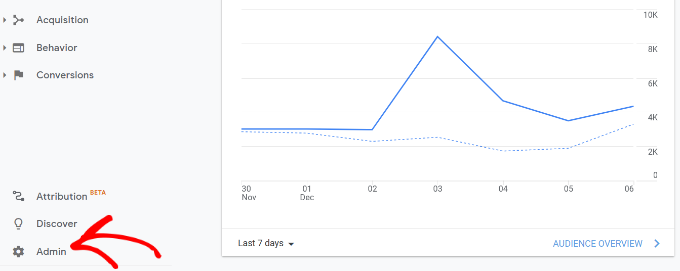
Next, you’ll need to head to the View column.
From here, simply click on ‘Goals.’
Next, you can start creating a new goal.
Simply click the ‘+ New Goal’ button.
There are 4 types of goals you can create:
- Destination: This tracks whether a visitor went to a specific page, like a thank you page, after filling in a form.
- Duration: This tracks how long a visitor spends on your website.
- Pages/Screens per session: This tracks how many pages someone looks at on your site.
- Event: This can track all sorts of things, like button clicks, video plays, and downloads. It requires a bit more setup than the other options.
In many cases, Destination or Event goals will work best for tracking your key metrics.
We’re going to create a Destination goal for this example. Give your goal a name, click the radio button next to ‘Destination’ to set the type, and then click the ‘Continue’ button.
Next, you will need to enter the destination for your goal. This will normally be a specific page.
Note: Only enter the part of the URL that comes after your website’s domain name.
For instance, if your page is:https://www.example.com/thank-you-for-booking/
Then you should enter:/thank-you-for-booking/
You can add a value for the conversion if you want. This makes sense if people are completing a payment form or if you know how much each lead is worth to you on average.
If you want to track a funnel, such as a customer moving through a checkout process, then you can also do this as part of the destination goal. This can help you pinpoint areas you might want to improve.
You can click the ‘Verify this Goal’ link to see what conversion rate the goal would have based on your data from the previous 7 days.
If you get 0% and know that you’ve had some form submissions, check the destination URL you’ve entered.
Once you’re happy with your goal, click the ‘Save’ button. You should then see your goal listed in a table. You can edit it, switch it off and on, or create more goals here.
You can’t delete goals once you’ve created them, so you will need to simply switch them off if you no longer want to use them.
You can view your goal data in Google Analytics by going to Conversions » Goals, then clicking on Overview.
In the left-hand menu, you can dig further into your goals.
For instance, ‘Reverse Goal Path’ shows you what content visitors viewed before reaching the goal. Goal Flow can be used to examine all sorts of things, like the source that the visitors came from.
How to Replace Goals with Events in Google Analytics 4
As we mentioned before, Google Analytics 4 (GA4) is the new version of Google’s analytics platform. One of the main differences between GA4 and Universal Analytics is that there are no goals in the latest version.
That’s because Google Analytics 4 uses a completely different method of tracking and recording data. Instead of goals, it uses events to track user interactions and activities on your website.
You can create a custom event by logging into your GA4 property and then heading to the Admin settings.
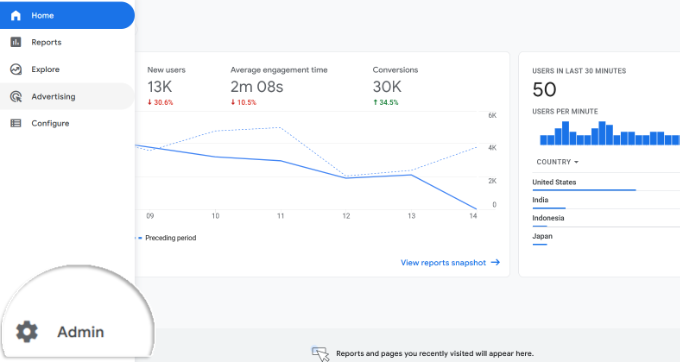
After that, go to the Property column.
Simply click on the ‘Events’ option.
Next, you will need to add a new event in GA4.
Go ahead and click the ‘Create event’ button.
A new window will now slide in from the right, where all your custom events will be listed once they’re created.
You can click the ‘Create’ button to get started.
Next, you will need to enter details for your custom event.
You can start by entering a custom event name. GA4 already has many prebuilt events, so you can select one from the dropdown menu. For example, we will choose the ‘file_download’ event for this tutorial.
When you select an event name, GA4 will automatically enter the specific Parameter and Operator for the event. In this case, the event will be tracking the ‘event_name’ when it ‘equals’ a Value you will enter next.
In the ‘Value’ field, we will enter ‘.pdf’ so it tracks the number of downloads when a user downloads a file with the PDF extension. You might also use .epub for ebooks or even a specific word you use to organize filenames such as ‘v2’ or ‘_2023version.’
Once you’ve entered all the details, don’t forget to click the ‘Create’ button at the top.
You should now see your new event under the Custom events area of your dashboard.
Next, you can view reports to see the performance of your custom events.
Simply head to Reports » Engagement » Event: Event name from the menu on your left.
While setting up Events in GA4 is pretty easy, if you want to track multiple things, it can take a long time.
That’s why we think that if you want a simple way to set up event and goal tracking in Google Analytics, then MonsterInsights is definitely the way to go.
Setting up manual goals in Google Analytics might work for you if you’re confident using the Google Analytics interface, or if you have a lot of extra time on your hands.
What matters is that you create and track meaningful goals for your site. This is where MonsterInsights is beneficial, as you can use the data to boost signups, increase sales, and make more money or impact with super easy setup and reporting.
We hope this article helped you learn how to set up Google Analytics goals for your WordPress site. You may also want to see our guide on how to increase your website traffic and our pick for the best email marketing services.
If you liked this article, then please subscribe to our YouTube Channel for WordPress video tutorials. You can also find us on Twitter and Facebook.
The post How to Set Up Google Analytics Goals for Your WordPress Site first appeared on WPBeginner.
